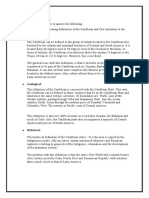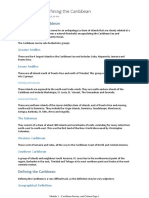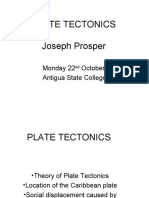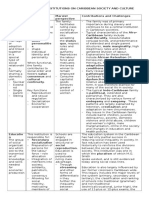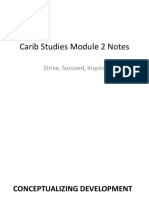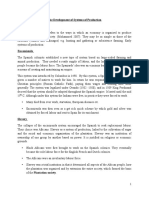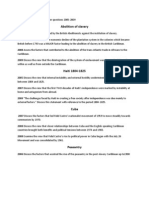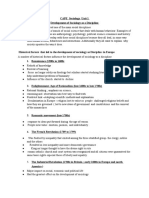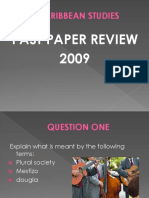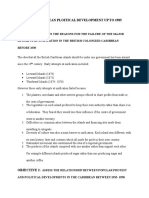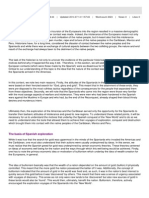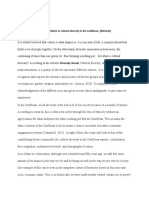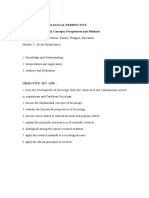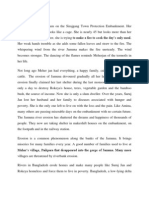Caribbean Studies (1) - Location of The Caribbean
Caribbean Studies (1) - Location of The Caribbean
Uploaded by
dawin_mornaCopyright:
Available Formats
Caribbean Studies (1) - Location of The Caribbean
Caribbean Studies (1) - Location of The Caribbean
Uploaded by
dawin_mornaOriginal Description:
Original Title
Copyright
Available Formats
Share this document
Did you find this document useful?
Is this content inappropriate?
Copyright:
Available Formats
Caribbean Studies (1) - Location of The Caribbean
Caribbean Studies (1) - Location of The Caribbean
Uploaded by
dawin_mornaCopyright:
Available Formats
Caribbean Studies
Module 1 : Caribbean Society and Culture.
Topic : Location and Definition of the Caribbean Region
* Geographical Location
Geographical Location of the Caribbean.
The Caribbean region, located in the tropics, extends in a broad arc of over 4000 km from the Bahamas in the north to Guyana and Suriname in the south. The region also includes, based on historical factors, Belize which is in Central America bordering Mexico and Guatemala.
The Greater Antilles
The islands of the Greater Antilles include Jamaica , Hispaniola , Cuba and Puerto Rico.
The Lesser Antilles
The islands include Antigua and Barbuda, Trinidad and Tobago, St. Vincent and the Grenadines, Barbados , St. Lucia, etc.
Which islands are the Windward and Leeward Islands ?
The Windward Islands and Leeward Islands are part of the Lesser Antilles of the Caribbean sea. The Windward Islands are part of the Lesser Antilles of the Caribbean Sea. The Windward Islands are southeastern islands of the Caribbean and include Martinique,St. Lucia,St. Vincent , the Grenadines and Grenada. They are called the Windward Islands because they are exposed to the wind (windward) of the northeast trade winds. (northeasterlies) The Leeward Islands include the Virgin Islands,Dominica,Guadeloupe,Montserrat,Antigua,Barbuda,St. Kitts, Nevis and Anguilla.
Definitions of the Caribbean Region
The Geographical Caribbean this describes the area washed by the Caribbean Sea and is often described as the Caribbean Basin. It would therefore include most of the islands of the Lesser and Greater Antilles as well as the mainland territories of Central America and Northern South America such as Venezuela and Columbia.
NB: Notice that the territories in red all have one common feature, they are all washed by the Caribbean Sea, even though they may speak different languages.
The Geological Caribbean this is not as well-used as the other ways by which we define the Caribbean region. However, it shows that there are deep-seated structural features of Caribbean geology which also identifies commonalities. It is the area that is defined by the Caribbean Plate and which expresses similar tectonic, seismic and volcanic features and processes.
The Caribbean Plate
NB. The Caribbean is situated in a geologic feature known as the Caribbean Plate which has boundaries or margins with other plates nearby. A plate is a large piece of crust (on which there may be both land and ocean) and it moves in relation to other plates. On the whole the earth is made up of six or seven plates and many smaller ones. The Caribbean Plate is a small plate. Other geological features of the region include the fact that: A) the entire Caribbean region is in an earthquake zone B)the Lesser Antilles is made up of volcanoes, several of which are active
The Historical Caribbean this describes the area that saw the impact of European colonization, slavery, indentureship and the plantation system. This refers to all the territories, so that one means by which we can define the Caribbean is by identifying those countries that experienced the rule of specific European countries, namely the English, French, Dutch and the Spanish. The common feature in this definition is that they share the same historical or cultural experiences.
LEGEND
ENGLISH
SPANISH FRENCH DUTCH
NB: The legend indicates the territories that were under the control of the various European powers. It should be noted that Guyana (which was first under Dutch control, then English), Surinam (which was under Dutch control) and French Guiana (which is STILL under French control) are not represented in Fig. 3. They are apart of the Caribbean because they share the same historical/cultural experiences as all those which are represented in fig. 3
The Political Caribbean the Caribbean has three main government systems, namely
A) Independent States these are former colonies which are now self-governing. These are islands which have chosen a method of governance that is different from that of their colonial masters, namely democracy or communism;
B) Associated States these are territories which are not independent but enjoy all the rights and privileges of the country that governs it; C) Colonial Dependencies these ate territories which are directly governed by other countries but do not enjoy the rights and privileges thats enjoyed by inhabitants in an Associated State.
LEGEND Independent States Associated State Colonial Territories
Problems in defining the Caribbean
Geographical
1.
Historical
The problem with defining the Caribbean according to linguistic or European heritage, is that, that tends to ignore the commonalities of Caribbean experience at the hands of these colonial powers. This definition would include Guyana and the Bahamas. It should also include the French, Dutch and Spanish speaking countries of the Caribbean and Central America.
Geological
The western edge of the Caribbean Plate is located in the Pacific and includes Honduras, Costa Rica, Nicaragua and Panama in the Caribbean.
Guyana and the Bahamas do not have coastlines on the Caribbean Sea. Yet both countries are commonly accepted as part of the Caribbean
2.
This definition includes countries not normally associated with the Caribbean Panama, Columbia and the other countries of Central America.
The northern edge of the Caribbean Plate defines much of Belize, Cuba and the Bahamas as extraregional. Similarly Guyana in the South.
You might also like
- Caribbean Political Development Up To 1985Document67 pagesCaribbean Political Development Up To 1985Mikaelia Nesbeth100% (2)
- Caribbean Studies Module 3Document18 pagesCaribbean Studies Module 3Shavane DavisNo ratings yet
- Carib Review From Steven-2 PDFDocument149 pagesCarib Review From Steven-2 PDFSabrina Mcdermott100% (2)
- Locating and Defining The CaribbeanDocument29 pagesLocating and Defining The CaribbeanRoberto Saladeen100% (2)
- Geographical Definition of The CaribbeanDocument1 pageGeographical Definition of The CaribbeanJordy13No ratings yet
- Impact of Societal Institutions On Caribbean PeopleDocument50 pagesImpact of Societal Institutions On Caribbean PeopleCleon Roxann Webbe100% (1)
- DRRM in SchoolsDocument22 pagesDRRM in SchoolsSalvador Dagoon Jr100% (3)
- A History of Significant Weather Events in Southern CaliforniaDocument119 pagesA History of Significant Weather Events in Southern CaliforniaGregoreuoNo ratings yet
- Caribbean Studies - Definition of The Caribbean.Document2 pagesCaribbean Studies - Definition of The Caribbean.Cristiano RaghubarNo ratings yet
- Location and Definition of The CaribbeanDocument38 pagesLocation and Definition of The CaribbeanTjNo ratings yet
- Module 1 - Caribbean Society and Culture PDFDocument53 pagesModule 1 - Caribbean Society and Culture PDFParis Love100% (1)
- Definitions 2013Document4 pagesDefinitions 2013NarvinLallsaroopNo ratings yet
- Location and Definition of The CaribbeanDocument15 pagesLocation and Definition of The CaribbeanTorica Noray100% (1)
- CAPE CARIBBEAN STUDIES - STUDY GUIDEDocument65 pagesCAPE CARIBBEAN STUDIES - STUDY GUIDEJayda JosephNo ratings yet
- Carib StudiesDocument3 pagesCarib StudiesLeighton ThompsonNo ratings yet
- Definition of The CaribbeanDocument2 pagesDefinition of The CaribbeanBrianna AllenNo ratings yet
- Caribbean IdentityDocument15 pagesCaribbean IdentityJamion Knight100% (6)
- Caribbean Studies Notes 1-3Document2 pagesCaribbean Studies Notes 1-3Latoya Toya Ebanks100% (2)
- Caribbean Peoples Response To Oppression and GenocideDocument36 pagesCaribbean Peoples Response To Oppression and GenocideDaneilla Banks80% (5)
- Caribbean Studies - Plate TectonicsDocument24 pagesCaribbean Studies - Plate TectonicsJamion Knight100% (1)
- Impact of Social Institutions On Caribbean Society and CultureDocument4 pagesImpact of Social Institutions On Caribbean Society and CultureLeighton Thompson100% (3)
- " Foster" - Ing Caribbean Studies: C.A.P.EDocument45 pages" Foster" - Ing Caribbean Studies: C.A.P.ETashane officialNo ratings yet
- Caribbean Studies Impacts of Geographical PhenomenaDocument48 pagesCaribbean Studies Impacts of Geographical PhenomenaRéliç Réid92% (12)
- CAPE History Unit 1history Unit Plans 07Document7 pagesCAPE History Unit 1history Unit Plans 07AW100% (2)
- Internal Assesment For Caribbean StudiesDocument20 pagesInternal Assesment For Caribbean StudiesBrandonNo ratings yet
- Caribbean Studies: MODULE 1Document2 pagesCaribbean Studies: MODULE 1Danny Anngenie Sookoo100% (1)
- CAPE June2011 Sociology Unit2 Ques2.ExDocument9 pagesCAPE June2011 Sociology Unit2 Ques2.ExJordy13No ratings yet
- Caribbean Studies Plantation SocietyDocument4 pagesCaribbean Studies Plantation Societysmartkid167100% (1)
- CAPE HISTORY Past Paper Questions 2005-2009Document3 pagesCAPE HISTORY Past Paper Questions 2005-2009Abhimanyu Dev100% (2)
- The Typical 18th Century Sugar Estate or PlantationDocument6 pagesThe Typical 18th Century Sugar Estate or PlantationTiana Chevannes100% (2)
- History Sba ResearchDocument4 pagesHistory Sba ResearchKerissa Kissoon100% (1)
- Carib Studies Module 2 NotesDocument96 pagesCarib Studies Module 2 NotesMika Vaughn100% (1)
- The Development of Systems of ProductionDocument3 pagesThe Development of Systems of ProductionDaneilla Banks40% (5)
- Cape HistoryDocument2 pagesCape HistoryOctaviaNatassieWalcott100% (1)
- Proto PeasantryDocument3 pagesProto PeasantryVennessa Salvatore0% (1)
- Powerpoint On Settlement Pattern of Indigenous PeopleDocument7 pagesPowerpoint On Settlement Pattern of Indigenous PeopleDance-Off 15No ratings yet
- Caribbean Studies - Lesson 9 - Past Paper PDFDocument14 pagesCaribbean Studies - Lesson 9 - Past Paper PDFTime gamer100% (1)
- Caribbean Arts & Popular Culture in The RegionDocument30 pagesCaribbean Arts & Popular Culture in The Regionapi-28259382550% (2)
- Caribbean Studies Short Essay On The CultureDocument11 pagesCaribbean Studies Short Essay On The CulturerichardNo ratings yet
- The Development of Systems of ProductionDocument4 pagesThe Development of Systems of ProductionkayannaNo ratings yet
- Uwi - Foun1101 - Caribbean Civilization - Topic 1Document15 pagesUwi - Foun1101 - Caribbean Civilization - Topic 1payel02000100% (8)
- CAPE HISTORY Unit 1past Paper Questions 2005Document1 pageCAPE HISTORY Unit 1past Paper Questions 2005Nessa_AyyeNo ratings yet
- Caribbean Studies - The Nature and Purpose of Research 2014Document3 pagesCaribbean Studies - The Nature and Purpose of Research 2014Daneilla BanksNo ratings yet
- Earthquakes in The CaribbeanDocument2 pagesEarthquakes in The CaribbeanKeishaun Justin JulienNo ratings yet
- Explain FOUR Measures Which Governments Can Use To Encourage Entrepreneurial Activities in The Caribbean Region.Document2 pagesExplain FOUR Measures Which Governments Can Use To Encourage Entrepreneurial Activities in The Caribbean Region.Bridget SequeaNo ratings yet
- The Demerara Rebellion of 1823 PresentationDocument7 pagesThe Demerara Rebellion of 1823 PresentationPhelisaNo ratings yet
- CAPE Sociology Unit 1 .2Document2 pagesCAPE Sociology Unit 1 .2Drip BossNo ratings yet
- Caribbean Studies 2011#6Document3 pagesCaribbean Studies 2011#6avalonNo ratings yet
- CAPE CARIBBEAN STUDIES IntegrationDocument36 pagesCAPE CARIBBEAN STUDIES IntegrationSeondre Daye100% (1)
- CAPE Caribbean Studies Solution 2009Document62 pagesCAPE Caribbean Studies Solution 2009SashidaeNo ratings yet
- Historynotes Theme8Document11 pagesHistorynotes Theme8JM Mondesir86% (7)
- Caribbean Art FormsDocument67 pagesCaribbean Art FormsAshleyNo ratings yet
- Caribbean StudiesDocument6 pagesCaribbean StudiesAudi Sweetangel100% (5)
- (B) The Basis of Spanish Settlements in The Caribbean Up To 1600 and Mexico and Peru Up To 1550Document3 pages(B) The Basis of Spanish Settlements in The Caribbean Up To 1600 and Mexico and Peru Up To 1550Jelani GreerNo ratings yet
- Caribbean Studies Exam Questions (Paper Two)Document26 pagesCaribbean Studies Exam Questions (Paper Two)Donnell FrancisNo ratings yet
- Ry Cultural Diversity Im The Caribbean EssayDocument3 pagesRy Cultural Diversity Im The Caribbean EssayRyNo ratings yet
- 0.US in Caribbean 1776 To 1870Document20 pages0.US in Caribbean 1776 To 1870Tj Roberts100% (1)
- Readings in Caribbean Studies PDFDocument227 pagesReadings in Caribbean Studies PDFchogiwa & kkaebsongs love childNo ratings yet
- Sociology Outline - Syllabus RequirmentsDocument12 pagesSociology Outline - Syllabus Requirmentsmashronee blissettNo ratings yet
- Cepheid Variables LabDocument3 pagesCepheid Variables Labdawin_mornaNo ratings yet
- Cain Reynolds OdesDocument416 pagesCain Reynolds Odesdawin_mornaNo ratings yet
- IntegrationDocument7 pagesIntegrationdawin_morna67% (3)
- Spectrophotometric Determination of Iron Using 1,10-PhenanthrolineDocument9 pagesSpectrophotometric Determination of Iron Using 1,10-Phenanthrolinedawin_mornaNo ratings yet
- The Effect of Globalization On Caribbean CountriesDocument24 pagesThe Effect of Globalization On Caribbean Countriesdawin_mornaNo ratings yet
- Bio MCQ Unit 2Document10 pagesBio MCQ Unit 2dawin_mornaNo ratings yet
- 2010 CAPE Unit 2 Bio MCQDocument10 pages2010 CAPE Unit 2 Bio MCQdawin_morna83% (6)
- Act 2Document5 pagesAct 2Alexander Cabrales0% (1)
- Elizabeth Kaylee FricksDocument6 pagesElizabeth Kaylee Fricksapi-253310656No ratings yet
- Hurricane Vs TornadoesDocument11 pagesHurricane Vs TornadoesMelanie Valladares RNo ratings yet
- Flash Floods and Floods... The Awesome Power!: #1 Weather-Related Killer in The United States!Document12 pagesFlash Floods and Floods... The Awesome Power!: #1 Weather-Related Killer in The United States!Ivan BodnaryukNo ratings yet
- 2004 Indian Ocean Earthquake and TsunamiDocument31 pages2004 Indian Ocean Earthquake and TsunamisomeoneuploadedthisNo ratings yet
- Grapes of Wrath (Movie Vs Book)Document5 pagesGrapes of Wrath (Movie Vs Book)prettyhowtown23No ratings yet
- Global and Local WindsDocument16 pagesGlobal and Local Windsmarjory albertoNo ratings yet
- Poem Analysis Chart 2Document2 pagesPoem Analysis Chart 2Andrea OhNo ratings yet
- B1+ Reading 6 - Storm ChaserDocument1 pageB1+ Reading 6 - Storm ChaserTrioGarage75% (4)
- The Passing Away of A GentlemanDocument15 pagesThe Passing Away of A GentlemanAustin Macauley Publishers Ltd.No ratings yet
- Remote Sensing ApplicationsDocument14 pagesRemote Sensing ApplicationsShivaniSharmaNo ratings yet
- CycloneDocument10 pagesCycloneblurbNo ratings yet
- Passive VoiceDocument1 pagePassive VoiceDanny A SandhyNo ratings yet
- Mapa Mundial de Los Sistemas de Alerta de TsunamiDocument1 pageMapa Mundial de Los Sistemas de Alerta de TsunamiJoaquin EnriqueNo ratings yet
- Mus Tractor EbroDocument2 pagesMus Tractor EbroJorge Juan Garcia IgualadaNo ratings yet
- FEMA MapDocument1 pageFEMA MapHouston ChronicleNo ratings yet
- The Trevione Hudson Resume HudDocument3 pagesThe Trevione Hudson Resume Hudapi-233878163No ratings yet
- Bermuda TriangleDocument12 pagesBermuda TriangleCristinaRăileanu0% (1)
- Meher Jan Lives in A Hut On The Muddy Floor of Sirajgang Town Protection EmbankmentDocument2 pagesMeher Jan Lives in A Hut On The Muddy Floor of Sirajgang Town Protection EmbankmentSharmin ShimiNo ratings yet
- Science - Types of Clouds BookletDocument16 pagesScience - Types of Clouds Bookletfayroozb100% (1)
- Weatehr Fax Chart InfoDocument9 pagesWeatehr Fax Chart InfoPrateek GandhiNo ratings yet
- CECR Proposal FormDocument9 pagesCECR Proposal FormSwarupNo ratings yet
- Daedalus EssayDocument2 pagesDaedalus Essayjessik40100% (1)
- Flowchart TimelineDocument1 pageFlowchart Timelineapi-249559754No ratings yet
- Brunei ClimateDocument10 pagesBrunei ClimateAimi AdamNo ratings yet
- Port Douglas 3 304Document1 pagePort Douglas 3 304Ngaire TaylorNo ratings yet
- Exercises 1 Deskriptivna GramatikaDocument21 pagesExercises 1 Deskriptivna GramatikaBonnie WarfieldNo ratings yet








